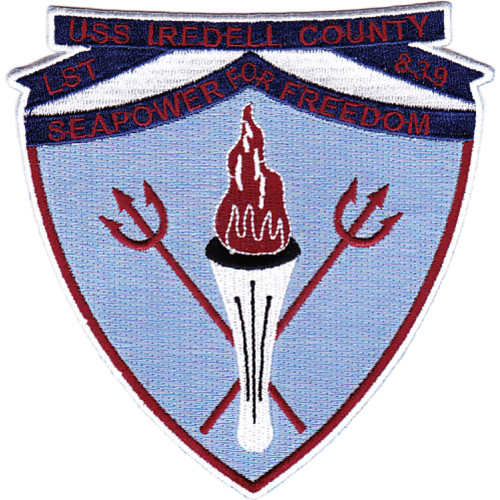Description
USS Iredell County LST 839 Tank Landing Ship Patch (U.S. Navy) 5.0" x 5.0" Embroidered Patch with Iron-On Backing
Superior Materials: Made with premium polyester thread and durable twill fabric, ensuring long-lasting color and strength.
Advanced Embroidery Technology: Crafted using the most advanced embroidery machinery, guaranteeing intricate detail, sharp lines, and consistent quality every time.
Easy Iron-On Application: Features a heat-activated adhesive backing for quick, no-sew attachment. Simply position, iron, and press for a secure bond.
Versatile Use: Perfect for personalizing jackets, backpacks, uniforms, or any fabric surface that needs a touch of personality.
Durable and Washable: Designed to withstand everyday wear and occasional washing without fading or fraying.
Formations & Origins
The USS Iredell County (LST-839) was a LST-542-class tank landing ship commissioned by the United States Navy during World War II. Built by the American Bridge Company in Ambridge, Pennsylvania, she was laid down on September 25, 1944, launched on November 12, 1944, and commissioned on December 6, 1944, with Lieutenant Waldo F. McNeir in command. The ship was named after Iredell County, North Carolina, and was the only U.S. naval vessel to bear the name. Following her service in World War II, she was decommissioned in July 1970 and transferred to the Indonesian Navy, where she served as KRI Teluk Bone (511) until her decommissioning in 2019. Plans were made to preserve her as a museum ship .
Notable Commanders
Specific commanders of the USS Iredell County during her service are not detailed in the available sources. However, like other naval vessels of her class and era, she was commanded by experienced naval officers responsible for overseeing her operations and ensuring the safety and effectiveness of her crew during various missions.
Major Campaigns/Operations
During World War II, LST-839 was assigned to the Asiatic-Pacific Theater and participated in the assault and occupation of Okinawa Gunto from April through June 1945. After the war, she performed occupation duty in the Far East until mid-September 1945. She returned to the United States and was decommissioned in March 1946, entering the Pacific Reserve Fleet. In 1966, she was recommissioned and served extensively during the Vietnam War, participating in numerous campaigns, including the Vietnamese Counteroffensive Phases II, III, IV, and VII, as well as the Tet Counteroffensive. She was decommissioned again in July 1970 and transferred to the Indonesian Navy, where she served as KRI Teluk Bone (511) until her decommissioning in 2019 .
Specialized Role/Equipment
As a tank landing ship, LST-839 was designed to transport and land tanks, vehicles, cargo, and troops directly onto hostile shores. She was equipped with a bow ramp that allowed for beach landings, making her a vital asset in amphibious operations. Her design enabled her to operate in shallow waters, providing flexibility in landing operations. During her service, she was armed with various weaponry to defend herself and her crew, including 40mm and 20mm anti-aircraft guns. Her ability to carry heavy loads and land directly on shore made her an indispensable part of amphibious assault forces during both World War II and the Vietnam War .
Acts of Heroism
While specific acts of heroism by the USS Iredell County and her crew are not detailed in the available sources, the nature of her missions during both World War II and the Vietnam War placed her and her crew in situations where courage and dedication were paramount. Operating in combat zones, often under fire, and executing complex landing operations required exceptional bravery and professionalism from all aboard.
Legacy & Notable Achievements
The USS Iredell County earned one battle star for her World War II service and, as Iredell County, received the Presidential Unit Citation, Navy Unit Commendation, Navy Meritorious Unit Commendation, and nine campaign stars for her Vietnam War service. These accolades reflect her significant contributions to U.S. military operations during both conflicts. After her decommissioning from the U.S. Navy, she was transferred to the Indonesian Navy, where she continued to serve until 2019. Plans to preserve her as a museum ship aim to honor her legacy and the service of her crew .






